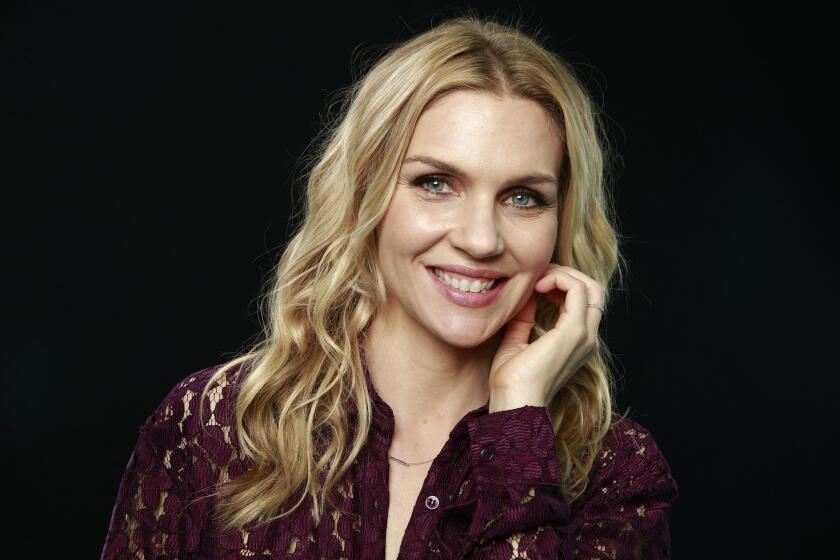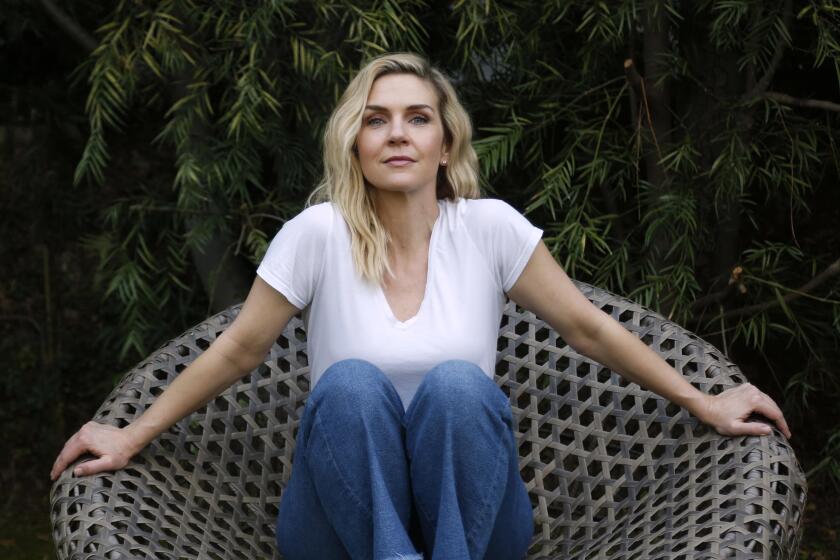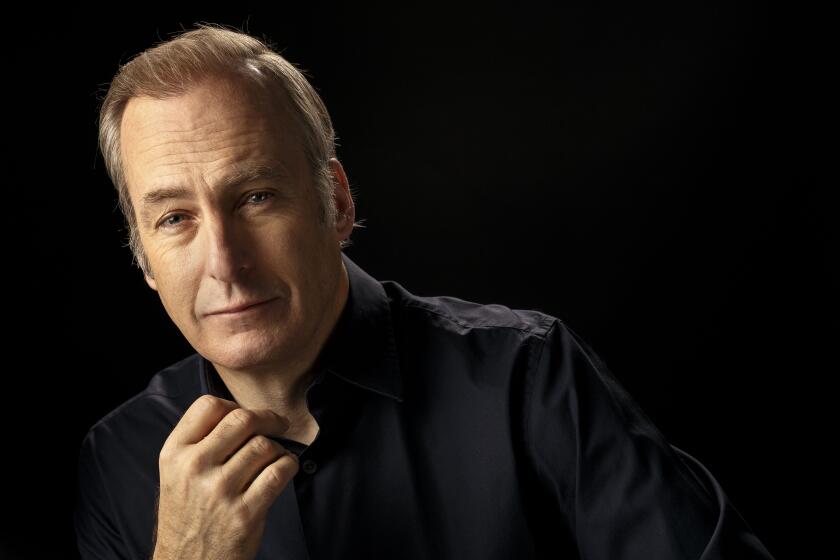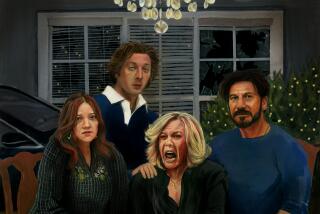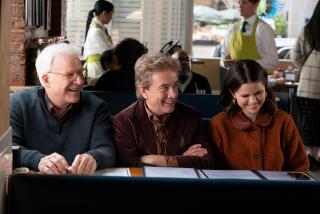How ‘Better Call Saul’ turned Kim’s ‘scammy side’ into an indelible turning point
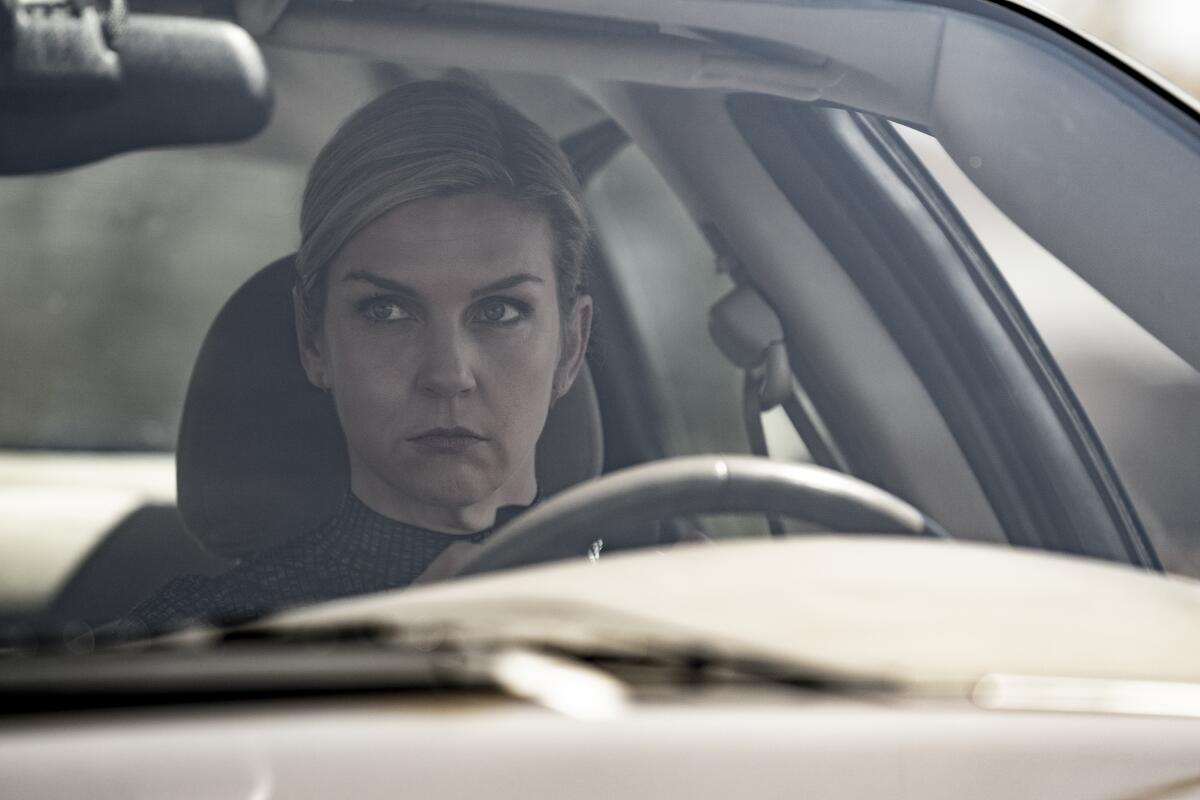
- Share via
This story contains spoilers for “Better Call Saul’s” two-part Season 6 premiere, “Wine and Roses” and “Carrot and Stick.”
Kim Wexler (Rhea Seehorn) and Jimmy McGill/Saul Goodman (Bob Odenkirk) are back, and with them comes the cutthroat world of “Better Call Saul” as it nears its conclusion.
The AMC series’ sixth and final season — two years removed from the Season 5 finale — returned on Monday with a doubleheader chock-full of major developments.
Here’s a quick lay of the land: Nacho Varga’s (Michael Mando) life is at stake; Lalo Salamanca (Tony Dalton) is on a path for revenge after Gus Fring’s (Giancarlo Esposito) plan to kill him failed; and Kim and Jimmy move forward with their increasingly elaborate plot to take down Howard Hamlin (Patrick Fabian).
In other words, just another day in Albuquerque.
Quite possibly the most striking moment, though, is in the last 10 minutes of its second episode — fittingly titled “Carrot and Stick” — when Kim’s darker side is on full display.
Kim and Jimmy have found the pawns for their con against Howard, but they differ in their preferred methodology. Following an unsuccessful attempt from Jimmy to use a “carrot” approach (bribing the pesky Kettlemans) Kim intentionally opts for a much more heavy-handed “stick” method.
She takes it a step further by threatening to turn them into the IRS during her ruthless intimidation. Kim’s threats are so menacing that she brings Betsy to tears and even appears to leave Jimmy shaken: “You think you’ve lost everything,” she tells them. “You have no idea.”
“Kim has gotten into the dangerous business of thinking that she’s the arbiter of what people ‘deserve’ at this point. She doesn’t like that [Jimmy’s] being soft with [the Kettlemans],” Seehorn told The Times. “It is a very dark moment for her.”
Seehorn, series co-creator Peter Gould and episode co-writer Thomas Schnauz explained how the final scenes came together and the various implications of this pivotal moment for Kim.
Rhea Seehorn’s male costars earned Emmy noms for “Better Call Saul.” Why has she never been nominated?
‘A means to an end’
Much of the discourse surrounding the early seasons of “Better Call Saul” revolved around the big three of Saul Goodman, Mike Ehrmantraut (Jonathan Banks) and eventually Gus Fring. But Kim, who doesn’t appear in “Breaking Bad,” has evolved into arguably the most complicated character in the whole series.
As the show has progressed (and especially in Season 5), Kim’s trajectory has strayed further from her typical pragmatism and closer to recklessness — and she seems to be enjoying every second of it. Her character’s development from a hard-nosed, by-the-book lawyer to a fearless con artist has been captivating to watch.
“There’s absolutely a scammy side to her, but I think she also has a drive to justice, which is a very interesting combination, and I love the way Rhea plays it,” Gould said.
The lines continue to blur regarding Kim’s morality, and her actions in “Carrot and Stick” are an unnerving turning point for the character.
“I definitely could see that it was a darker, more conscious and purposeful thing that she was doing,” Seehorn said. “It is a crystal-clear moment of ‘Kim did this, and she took it further than Jimmy.’ She can be ruthless when she decides which way she thinks the scales of justice should be tipping.”
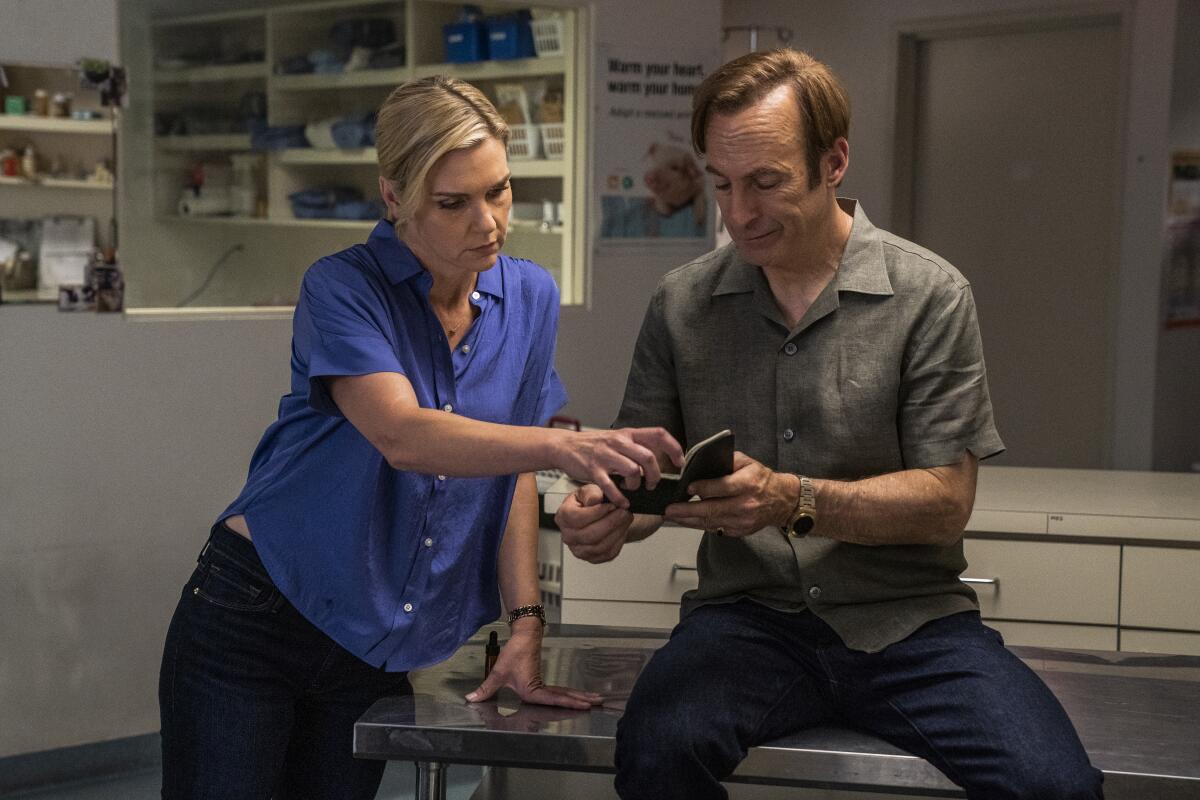
For her part, Seehorn and Gould explained, Kim sees her treatment of the Kettlemans as part of the greater good.
“I think she looks satisfied because she thinks this is a means to an end,” Seehorn said. “Everything they’re doing is so that they can open a law practice and help the people that really need it, and it doesn’t really matter who gets mowed down in the process.”
“Sometimes Kim feels that she knows better than the system does, and maybe she’s right, but there’s a lot of hazards to taking the position that you are going to be the ultimate arbiter of what’s right and wrong,” Gould added.
After going full force on the Kettlemans, it’s also clear that not only does Kim have no remorse for her ruthlessness, but she also enjoys putting them in their place. Schnauz, who is also an executive producer and sometimes director on the series, said that Kim’s complexities are what make her so interesting.
“It is darker, for sure, but she’s in denial about that. She doesn’t see it that way. What makes it so much fun to write is that she doesn’t quite understand the path that she’s going down, and she gets such a kick.”
Rhea Seehorn understands that attorney Kim Wexler could meet a bad end on the “Breaking Bad” prequel “Better Call Saul.” She’s relishing the “great mystery.”
The Kettlemans are back
Betsy and Craig Kettleman (Julie Ann Emery and Jeremy Shamos) were staples at the beginning of “Better Call Saul,” after the unassuming couple embezzled more than $1 million and found themselves entangled with Jimmy. But the couple had never reappeared until now.
The Kettlemans’ absurd, illegal schemes and hilarious relationship dynamic made the two characters instant fan favorites, despite only showing up in a handful of episodes.
“On the show, there’s actually very little improv; most of what the actors say is written by us. The Kettlemans are sort of the rare exception. [Shamos and Emery] would add little asides to each other, and we ended up using quite a few of them,” Gould said.
Their surprise cameo isn’t just satisfying fan service. It’s also something the writers have wanted to do for a while — they just needed to make sure the duo’s presence would move the story forward.
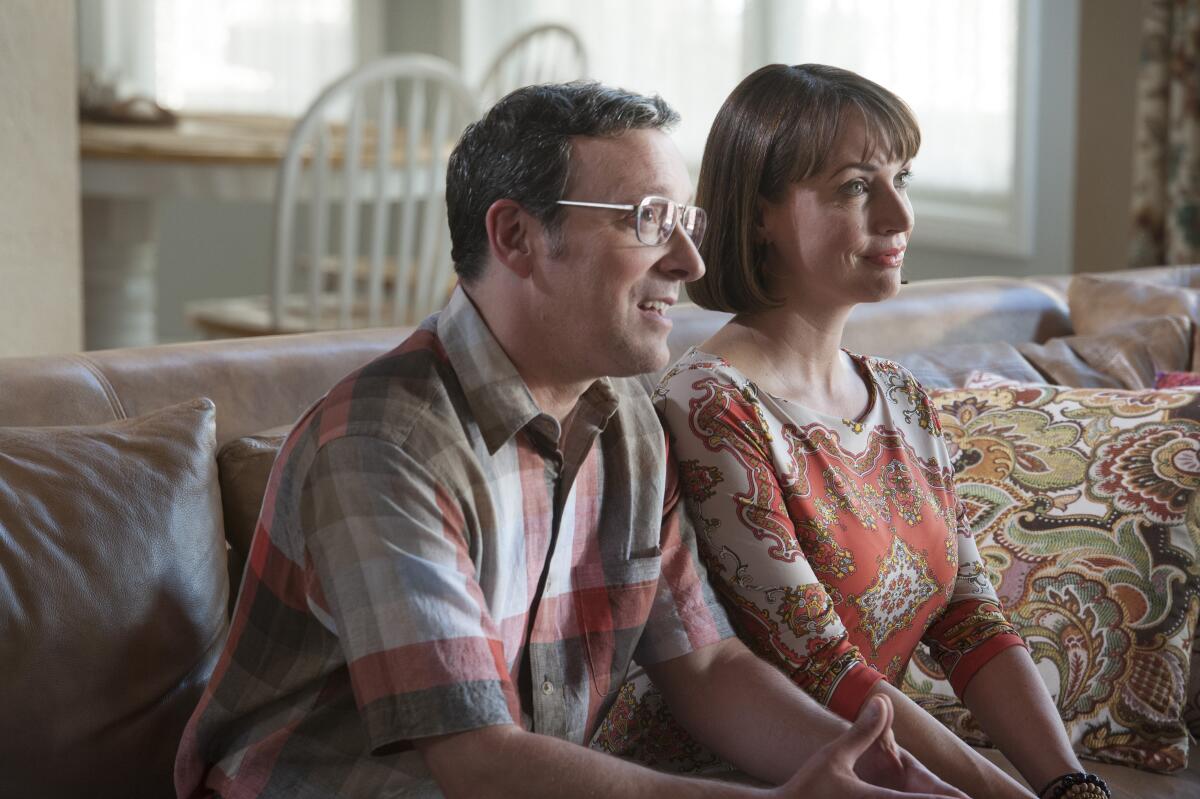
“When we started talking about what Jimmy and Kim’s scheme was, that’s when we started considering that maybe the Kettlemans could play a real part,” Schnauz said.
Though years have passed, the greedy duo seems to have learned little from their run-ins with the law. This time, their white-collar crimes come in the form of tax-preparer fraud, in which they take advantage of elderly clients — making them the perfect target for Jimmy and an infuriating punching bag for Kim.
“Kim justifies everything she does by making it about helping the little guy and helping people in trouble,” Schnauz said. “We intentionally put someone walking out with a cane, definitely being cheated by the Kettlemans, for her to look at … so, in a way, she wants to punish them, she’s hoping for that ‘stick.’”
“Better Call Saul” actor Tony Dalton, who plays charming villain Lalo Salamanca, breaks down his role in the “Breaking Bad” spin-off’s Season 5 finale.
‘Bringing the hammer down’
In the director’s chair for this episode is none other than Vince Gilligan, the creator of “Breaking Bad” and co-creator of “Better Call Saul.” Seehorn talked about how they handled the intricacies of the scene between Kim, Jimmy and the Kettlemans.
“The audience has to dislike the Kettlemans, realize that they are actually hurting people, but also by the end, [the viewers] actually feel — and so does Jimmy — some sadness for them, which is quite the gymnastics to do in a scene,” she said.
Although the episode closes with Kim’s evisceration of the Kettlemans, it wasn’t like that in the script.
“We actually reversed the order of the scenes, and the [original] script actually ended with Mike [Ehrmantraut] getting the call from Nacho [Varga] … we flipped the scenes, and it just felt more dramatic,” Schnauz said of the decision, made after watching the episode in the editing room. “I think we felt ending with Kim bringing the hammer down on the Kettlemans was a bigger moment.”
Gould noted that Kim’s uncharacteristically flamboyant shirt — eerily reminiscent of one of Saul’s iconic suits — was meant to complement the darker tone of the scene.
“When we started the show, we had this idea that the legitimate world was less colorful than the world of the criminals,” he said. “We tend to use hotter colors when there’s something afoot in the criminal world, and there’s just no question that Kim is landing in that world with two feet. We’ll see where that takes her.”
Less than two months after suffering a small heart attack and collapsing on set, “Better Call Saul” star Bob Odenkirk gets back to work on the AMC drama.
What’s next for Kim?
While Kim lays into the Kettlemans, Jimmy is at a loss for words, shrinking into the background and looking elsewhere, almost as if he’s ashamed of what she’s doing. Obviously jarred by what’s happened, Jimmy softens the blow by giving the Kettlemans the money — something that Kim disapproves of.
What are we to make of this disconnect between the longtime allies?
“They’re very, very intelligent characters and — Bob and I have spoken about this at length — they’re so smart that they do see each other,” Seehorn said. “If somebody is acting like they don’t really want to do it, I don’t buy for a minute that they don’t take that in. But she then keeps going.”
After “Carrot and Stick,” the question of what happens to Kim becomes more urgent. What does this change in Kim, and the brewing disconnect between her and Jimmy, mean moving forward? Gould of course wouldn’t spoil anything, but he did tease some of what Season 6 holds in store.
“You learn a lot more about Kim this season. You don’t learn everything, but you learn a lot more about what she’s made of, how far she’s going to go, and you also get a little glimpse of where she was before the story started,” he said. “She’s right up there with Jimmy McGill and Walter White as one of those indelible, complex characters who are unpredictable but fascinating.”
More to Read
The complete guide to home viewing
Get Screen Gab for everything about the TV shows and streaming movies everyone’s talking about.
You may occasionally receive promotional content from the Los Angeles Times.
